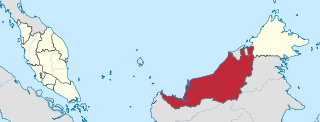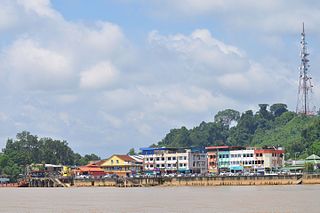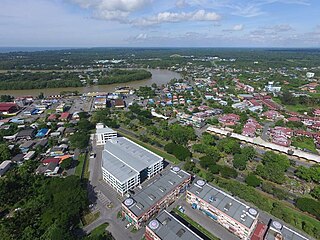
Sarawak is a state of Malaysia. The largest among the 13 states, with an area almost equal to that of Peninsular Malaysia, Sarawak is located in the region of East Malaysia in northwest Borneo, and is bordered by the Malaysian state of Sabah to the northeast, Kalimantan to the south, and Brunei in the north. The state capital, Kuching, is the largest city in Sarawak, the economic centre of the state, and the seat of the Sarawak state government. Other cities and towns in Sarawak include Miri, Sibu, and Bintulu. As of the 2020 Malaysia census, the population of Sarawak was 2.453 million. Sarawak has an equatorial climate with tropical rainforests and abundant animal and plant species. It has several prominent cave systems at Gunung Mulu National Park. Rajang River is the longest river in Malaysia; Bakun Dam, one of the largest dams in Southeast Asia, is located on one of its tributaries, the Balui River. Mount Murud is the highest point in the state. Sarawak is the only state of Malaysia with a Christian majority.

Kuching, officially the City of Kuching, is the capital and the most populous city in the state of Sarawak in Malaysia. It is also the capital of Kuching Division. The city is on the Sarawak River at the southwest tip of Sarawak on the island of Borneo and covers an area of 431 km2 (166 sq mi) with a population about 165,642 in the Kuching North administrative region and 159,490 in the Kuching South administrative region—a total of 325,132 people.

Sibu is a landlocked city located in the central region of Sarawak, Malaysia. It serves as the capital of Sibu District within Sibu Division and is situated on the island of Borneo. Covering an area of 129.5 square kilometres (50.0 sq mi), the city is positioned at the confluence of the Rajang and Igan Rivers, approximately 60 kilometres from the South China Sea and 191.5 kilometres (119 mi) north-east of the state capital, Kuching.

Bidayuh is the collective name for several indigenous groups found in southern Sarawak, Malaysia and northern West Kalimantan, Indonesia, on the island of Borneo, which are broadly similar in language and culture. The name Bidayuh means 'inhabitants of land'. Originally from the western part of Borneo, the collective name Land Dayak was first used during the period of Rajah James Brooke, the White Rajah of Sarawak. At times, they were also lesser referred to as Klemantan people. They constitute one of the main indigenous groups in Sarawak and West Kalimantan and live in towns and villages around Kuching and Serian in the Malaysian state of Sarawak, while in the Indonesian province of West Kalimantan they are mainly concentrated in the northern Sanggau Regency. In Sarawak, most of Bidayuh population can be found within 40 km of the geographical area known as Greater Kuching, within the Kuching and Serian Division. They are the second-largest Dayak ethnic group in Sarawak after the Iban and one of the major Dayak tribes in West Kalimantan.

Parti Pesaka Bumiputera Bersatu is a right-wing political party in Malaysia. It is currently the largest political party in Sarawak. Parti Pesaka Bumiputera Bersatu was formed from the combination of three parties in Sarawak; Parti Negara Sarawak, Barisan Rakyat Jati Sarawak and Parti Pesaka Anak Sarawak. The formation of the party was for the purpose of the improvement of the livelihood and protect the rights of the Bumiputera in many fields such as politics, economy and social. Formerly a part of Semenanjung-based coalition Barisan Nasional (BN), following the defeat of BN in the 2018 general election and in the aftermath of a meeting between all Sarawak-based BN coalition parties on 12 June 2018, PBB left the coalition to form a new Sarawak-based coalition, Sarawak Parties Alliance.

Kanowit is a town and the capital of Kanowit District, Sibu Division, Sarawak, Malaysia, comprising 2,253.5 square kilometres. As of 2010, Kanowit's population is 28,985. It is built on the mouth of Kanowit River at the bank of Rajang River, approximately 174 kilometers from the coast of South China Sea. It takes 45 minutes to reach the town by land transport and an hour by boat from Sibu. The main ethnic groups are Iban, Chinese, Malay, and Melanau.

Tun Pehin Sri Abang Haji Muhammad Salahuddin bin Abang Barieng was a Malaysian politician who served as the third Yang di-Pertua Negeri of Sarawak from 1977 to 1981, and as the sixth Yang di-Pertua Negeri from 2001 to 2014. He was the first Yang di-Pertua Negeri to hold the post twice, as well as the oldest elected to the office.

Kota Samarahan, formerly known as Muara Tuang, is a town and the administrative seat of the Samarahan District in Samarahan Division, Sarawak, Malaysia. It is also a satellite town for Kuching due to its proximity to the city part of Greater Kuching area. The Sarawak government position Kota Samarahan as the medical and education hub of the state. Saramahan is the heart of Sarawak Malays which is majority of 56%.

Melanau or A-Likou is an ethnic group indigenous to Sarawak, Malaysia. They are among the earliest settlers of Sarawak. They speak in the Melanau language, which is a part of the North Bornean branch of Malayo-Polynesian languages.

Padawan is a sub-district of Kuching District, Sarawak, Malaysia. The name is also used to refer to the local government in Sarawak, the Padawan Municipal Council, and to Bidayuh Village, which is also known as Kampung Padawan. The Jalan Padawan is the name of a road near mile 23 of Kuching-Serian Highway.
Petra Jaya National Secondary School is a public secondary school in Kuching, the capital of the East Malaysian state of Sarawak. As of 2015, the school has approximately 106 academic staffs and approximately 18 non-academic staffs. This school holds students from Peralihan to Form 6.

The sixth Sarawak state election was held between Friday, 27 September and Saturday, 28 September 1991. This election elected 56 state representatives into the Sarawak State Assembly. This election saw 72.8% of the eligible voters to cast their votes.
Sarawak's population is very diverse, comprising many races and ethnic groups. Sarawak has more than 40 sub-ethnic groups, each with its own distinct language, culture and lifestyle. This makes Sarawak demography very distinct and unique compared to its Peninsular counterpart. However, it largely mirrors to other territories in Borneo - Sabah, Brunei and Kalimantan.

Padawan Municipal Council is a local authority which administers Padawan municipality of the Kuching District, Sarawak, Malaysia. The agency is under the purview of Sarawak Ministry of Local Government and Community Development. MPP headquarters is located at Kota Padawan, at 10th mile away from Kuching city centre. The council aimed to improve infrastructure development and provide quality services to its residents besides preserving the environment.

Mukah (muːkəh), historically known as Muka is a coastal town which has served as the capital and the administrative center of the Mukah Division since 1 March 2002.
Sarawak exhibits notable diversity in ethnicity, culture, and language. The Sarawakian culture has been influenced by Bruneian Malays of the coastal areas. Substantial cultural influences also came from the Chinese and British cultures.

Sarawakian cuisine is a regional cuisine of Malaysia. Like the rest of Malaysian cuisine, Sarawak food is based on staples such as rice. There is also a great variety of other ingredients and food preparations due to the influence of the state's varied geography and indigenous cultures quite distinct from the regional cuisines of the Peninsular Malaysia. Sarawak is famous for its multi-ethnic population. As the homeland of many unique communities, Sarawak has a variety of cuisines rarely found elsewhere in Malaysia. The uniqueness of Sarawak well depends on its ethnic groups. Every native group in Sarawak has their own lifestyle, traditions, cultures and also foods. Sarawak cuisine is less spicy and has a subtle in taste. It uses fresh seafood and natural herbs like turmeric, lemongrass, ginger, lime and tapioca leaves. These ingredients are not only easily available, but also add a hint of aroma, texture and freshness to the delicacies. Food is one of the most cultural identities for native groups in Sarawak with each ethnic group having their own delicacies. Among the Iban, popular foods include tubu (stems), tuak and pansuh. The Malay have bubur pedas (porridge) and kek lapis Sarawak ; the Bidayuh have asam siok and sup ponas Bidayuh. The Melanau make tebaloi, sagu and umai and the Orang Ulu are known for garam barrio, kikid (broth), tengayen, and urum giruq (pudding).

The Sultanate of Sarawak was a Malay kingdom, located in present-day Kuching Division, Sarawak. The kingdom was founded in 1599, after the conquest of the preceding Santubong Kingdom and the later Sultanate of Brunei.

Tebedu District is a district in the state of Sarawak, Malaysia. It is a part of Serian Division that consists of Serian, Siburan, and Tebedu districts. Before this, Tebedu District was a sub-district under Serian District which was then fully upgraded to a district in its own right. The majority of the population of this district is from the Bidayuh ethnic group.


















